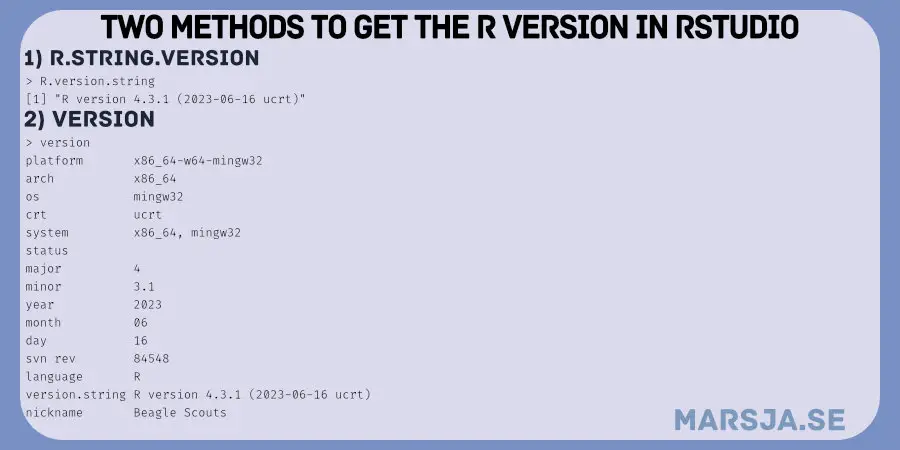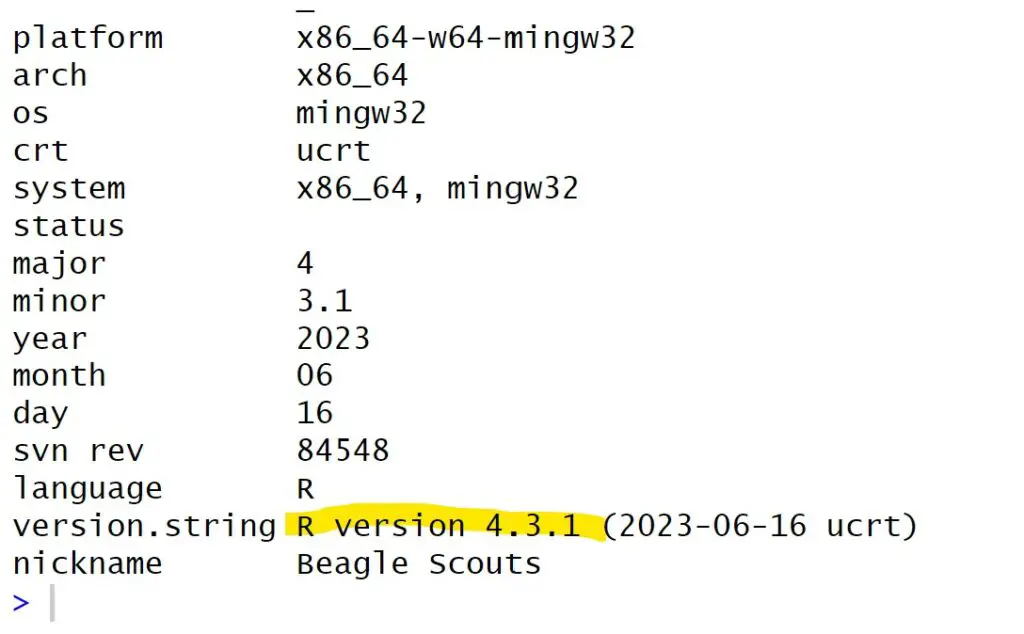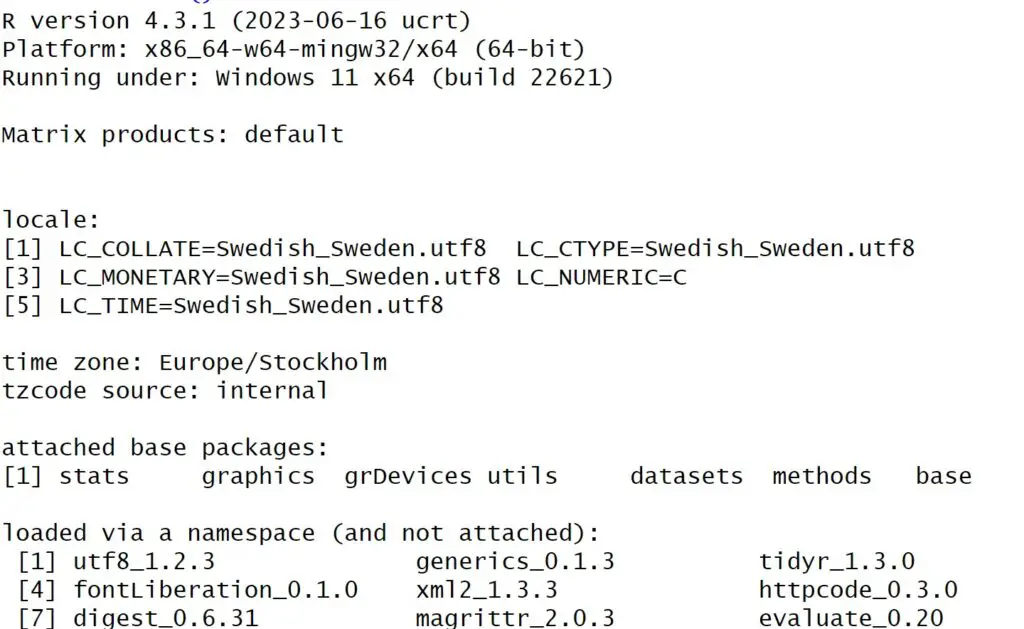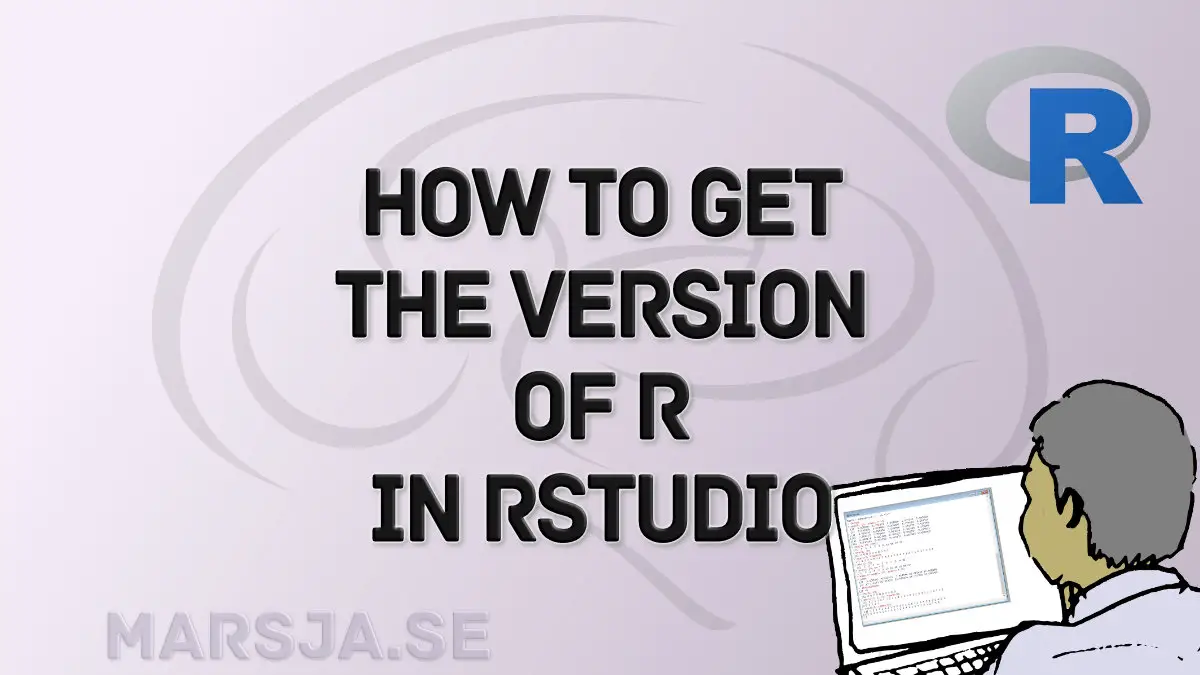In this tutorial, we will guide you on how to check the version of R in RStudio. Knowing your R version is crucial for compatibility with packages and ensuring smooth data analysis. In this post, we will cover step-by-step instructions to find your R version using easy-to-follow methods.
You can confidently install the necessary packages and execute code without unexpected errors by checking your R version. This knowledge is especially helpful when collaborating on projects or following online tutorials.
We will explore multiple ways to check your R version within the RStudio environment, making it accessible to all users, whether beginners or experienced data analysts. Additionally, we will provide tips on handling version differences and updating R to the latest release.
Knowing the R version in RStudio is essential for data analysts and programmers. This information lets you streamline your workflow, troubleshoot issues effectively, and maximize R’s capabilities. If you run an old version of R, see this blog post for information on how to update it: Update R: Keeping Your RStudio Environment Up-to-Date.

In the next section, you will find a detailed outline of the post. The following sections will unveil the methods and insights step-by-step.
Table of Contents
- Outline
- Prerequisites
- Example 1: Checking the R Version Using R.version.string
- Example 2: Check the R Version Using version
- Check R Version in RStudio Using the sessionInfo() Function:
- Best Method to Check R Version in RStudio?
- Conclusion
- Resources
Outline
The outline of the post is as follows. We will start by demonstrating how to utilize the R.version.string function in the RStudio Console to retrieve the R version details. This straightforward method gives us immediate access to the R version.
Next, we will learn how to use the version function to check the R version directly from the RStudio Console. This method offers a simple alternative for obtaining the R version information.
We will then explore the sessionInfo() function, a powerful utility in R, providing a comprehensive overview of the current R session, including the R version.
In this example, we will demonstrate how to extract the R version details using the sessionInfo() function. This method reveals the R version and offers valuable insights into the R environment.
Finally, we will evaluate the different methods and discuss which one is the most optimal for checking the R version in RStudio. We can determine the best approach for ensuring reproducibility and compatibility in our R data analysis projects by considering various factors.
Prerequisites
To check the R version in RStudio, you must be familiar with navigating RStudio’s interface. Ensure that RStudio is installed on your computer before proceeding.
Example 1: Checking the R Version Using R.version.string
Here are the steps to check the R version in RStudio using the console and the R.version.string function:
- Launch RStudio: Open RStudio on your computer. If you still need to install RStudio, you can download it from the official website.
- Access the Console: Once RStudio is open, you will find the Console window where you can interact with R. Here it is:
- Check R Version: In the Console, type the following command and press Enter:
R.version.string - Interpreting the Output: The output will show the R version in the following format:
R version x.x.x (YEAR-MONTH-DAY). Here, “x.x.x” represents the specific version numbers, and “YEAR-MONTH-DAY” denotes the release date of the R version.

It is worth pointing out that when working with RStudio, we have accessible options to determine the R version. Upon starting RStudio, the program promptly displays the R version in the initial messages, providing us with essential information immediately. The version information, presented as “R x.x.x,” is conveniently located at the top of the Console, ensuring immediate visibility. Even if we miss the startup message, we can always refer to the top of the Console, where RStudio consistently keeps the version info readily available. These straightforward methods make checking the R version in RStudio a hassle-free task. Here is a post about switching R version in RStudio:
Example 2: Check the R Version Using version
You can effortlessly determine the R version in RStudio using the version function. Follow these concise steps:
- Start RStudio: Start RStudio on your computer. Again, if you need to install RStudio, it is time to do that.
- Access the Console: After starting RStudio, find the Console window, where you can interact directly with R.
- Run the Command: In the Console, enter the following command to check the version and press Enter:
version
Using the version function allows us instant access to the R version information in RStudio.

Check R Version in RStudio Using the sessionInfo() Function:
The sessionInfo() function in R provides a comprehensive overview of the current R session, including essential details about the installed packages, loaded libraries, and, most importantly, the R version. Let us explore this function and learn how to extract R version details using it.
Example 3: How to extract R version Details Using sessionInfo():
Follow these steps to obtain the R version details using the sessionInfo() function:
- Open RStudio: Launch RStudio on your computer to access the R environment.
- Access the Console: Once you have started RStudio, locate the Console window where you interact with R. See the previous example for an image.
- Run the Command: In the Console, type the
sessionInfo()and press Enter to get the R version, among other things

Using the sessionInfo() function, we can gain valuable insights into the components and configuration of our R environment. This information includes version information. This knowledge empowers us to track package dependencies, manage compatibility, and ensure the reproducibility of our data analysis workflows. Understanding your R session’s context with sessionInfo() is a valuable skill for efficient and reliable programming in R.
Best Method to Check R Version in RStudio?
Checking the R version in RStudio is a fundamental step for data analysts and programmers to ensure compatibility and reproducibility. Three distinct methods offer solutions, each catering to different needs. The sessionInfo() method stands out regarding reproducibility. Because this function not only reveals the R version and provides a comprehensive snapshot of the R environment. This information includes loaded packages, their version, and other crucial information.
Consequently, this information can aid in tracking dependencies and maintaining consistency across projects, ensuring reproducibility. However, platforms like Binder are better for an even higher level of reproducibility. All in all, such platforms capture both R version and package dependencies in shareable, interactive environments. However, when a quick confirmation of the R version suffices, the version function or checking RStudio’s GUI during startup is the most efficient method.
Conclusion
This post explored various methods to check the R version in RStudio, ensuring compatibility and reproducibility in our data analysis projects. We began by familiarizing ourselves with the RStudio environment and locating the Console, the central interface for executing commands.
Through examples, we learned how to use the R.version.string and version functions in the Console to retrieve the R version information quickly. Additionally, we discovered the power of the sessionInfo() function, which provides a comprehensive overview of the R environment, including the R version and other crucial details.
We can confidently confirm the R version by selecting the appropriate method based on our needs, enabling seamless package compatibility and efficient code execution.
If you found this post helpful, consider sharing it on social media to help others benefit from this knowledge. I value your feedback and suggestions for future posts, so feel free to leave comments or request topics you would like to see covered.
Resources
Here are some great R tutorials that you may find helpful:
- How to Rename Column (or Columns) in R with dplyr
- R Count the Number of Occurrences in a Column using dplyr
- How to Add a Column to a Dataframe in R with tibble & dplyr
- R: Add a Column to Dataframe Based on Other Columns with dplyr
- How to Create a Sankey Plot in R: 4 Methods
- How to use %in% in R: 8 Example Uses of the Operator
- Coefficient of Variation in R
- Master or in R: A Comprehensive Guide to the Operator
